Why Adults Should Get Routine Anxiety Screening
What exactly IS anxiety?
We have all heard of it, but how do we know if we have it? And how do we know if it’s something we should be paying closer attention to?
Occasional anxiety is a normal part of life. Many people worry about things such as health, money, family problems, and relationships. But sometimes anxiety can interfere with our everyday functioning and activities. It’s important to understand the difference between “regular” anxiety and an anxiety disorder.
Anxiety disorders are a bit different than run-of-the-mill anxiety in that they involve more than temporary worry or fear. For people with an anxiety disorder, the anxiety does not go away and can get worse over time. The symptoms can interfere with our daily functioning and activities such as job performance, schoolwork, socialization and relationships. There are several types of anxiety disorders, including generalized anxiety disorder, panic disorder, social anxiety disorder, and various phobia-related disorders.
One of the most common anxiety disorders is Generalized Anxiety Disorder (GAD) which is characterized by excessive and persistent fear and anxiety about everyday events. This type of anxiety can interfere with daily life. It is not the same as occasionally worrying about things or experiencing anxiety due to stressful life events, which is a common reaction. People living with GAD experience frequent anxiety for months, sometimes even years.
Symptoms of GAD include:
Feeling restless, wound-up, or on-edge
Being easily fatigued
Having difficulty concentrating
Frequent irritability
Experiencing headaches, muscle aches, stomachaches, or unexplained pains
Difficulty controlling feelings of worry
Having sleep problems, such as difficulty falling or staying asleep
According to the National Institute of Mental Health (NIMH), anxiety disorders are among the most common mental health issue in the United States, affecting about 40 million adults. Yet only about 37% receive treatment for their anxiety. The pandemic has only aggravated this issue, sending cases soaring over the past two years. According to one study cited by the task force, between August 2020 and February 2021 the percentage of adults with recent symptoms of an anxiety or a depressive disorder increased to 41.5 percent from 36.4 percent. In addition, according to the World Health Organization, global prevalence of anxiety and depression increased by 25 percent during the first year of the pandemic.
So, what can we do about it?
For the first time, a panel of medical experts from the U.S. Preventative Services Task Force is recommending that adults under age 65 get screened for anxiety. These preventative screenings are designed to help primary care physicians identify early signs of anxiety during routine care, by using questionnaires and other screening tools.
Anxiety can go undetected quite frequently. The benefits of screening include early identification and treatment of an anxiety disorder. Based on the screening results, primary care physicians can refer their patients to a mental health care professional for a more thorough evaluation.
Why is this important?
Mental health conditions are just as important as other physical conditions, and we really need to be shining a light on and treating mental health conditions with the same urgency that we do other conditions. The “invisibility” of mental health conditions, like anxiety, can contribute to being frequently undiagnosed, which can then lead to further problems down the road such as depression, substance misuse, insomnia, digestive problems, headaches and overall poor quality of life. The recommendation of these new screenings is one step further in normalizing mental health conditions by making them part of routine visits with primary care physicians. Utilizing these screenings can help detect early identification of anxiety so that people can be informed and be referred to a mental health professional for proper diagnosis and treatment.
References: The National Institute of Mental Health; Diagnostic and Statistical Manual of Mental Health (DSM)
Click here for more information on anxiety therapy.

